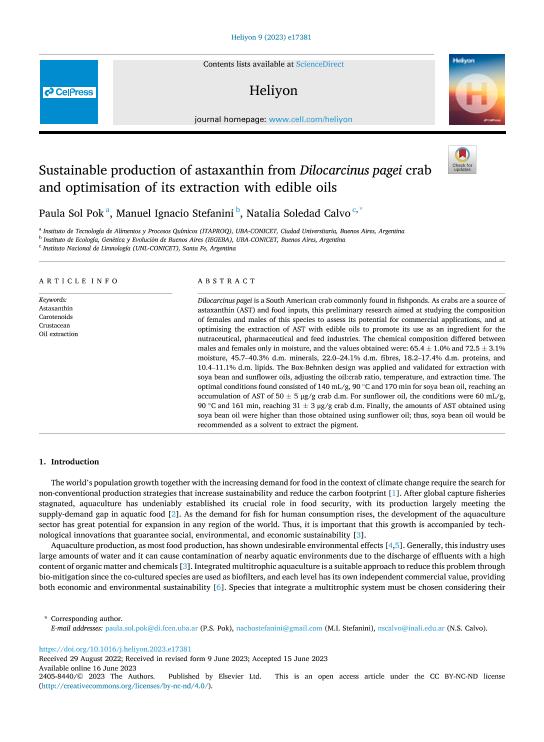Artículo
Sustainable production of astaxanthin from Dilocarcinus pagei crab and optimisation of its extraction with edible oils
Fecha de publicación:
06/2023
Editorial:
Elsevier
Revista:
Heliyon
ISSN:
2405-8440
Idioma:
Inglés
Tipo de recurso:
Artículo publicado
Clasificación temática:
Resumen
Dilocarcinus pagei is a South American crab commonly found in fishponds. As crabs are a source of astaxanthin (AST) and food inputs, this preliminary research aimed at studying the composition of females and males of this species to assess its potential for commercial applications, and at optimising the extraction of AST with edible oils to promote its use as an ingredient for the nutraceutical, pharmaceutical and feed industries. The chemical composition differed between males and females only in moisture, and the values obtained were: 65.4 ± 1.0% and 72.5 ± 3.1% moisture, 45.7–40.3% d.m. minerals, 22.0–24.1% d.m. fibres, 18.2–17.4% d.m. proteins, and 10.4–11.1% d.m. lipids. The Box-Behnken design was applied and validated for extraction with soya bean and sunflower oils, adjusting the oil:crab ratio, temperature, and extraction time. The optimal conditions found consisted of 140 mL/g, 90 °C and 170 min for soya bean oil, reaching an accumulation of AST of 50 ± 5 μg/g crab d.m. For sunflower oil, the conditions were 60 mL/g, 90 °C and 161 min, reaching 31 ± 3 μg/g crab d.m. Finally, the amounts of AST obtained using soya bean oil were higher than those obtained using sunflower oil; thus, soya bean oil would be recommended as a solvent to extract the pigment.
Palabras clave:
ASTAXANTHIN
,
CAROTENOIDS
,
CRUSTACEAN
,
OIL EXTRACTION
Archivos asociados
Licencia
Identificadores
Colecciones
Articulos(IEGEBA)
Articulos de INSTITUTO DE ECOLOGIA, GENETICA Y EVOLUCION DE BS. AS
Articulos de INSTITUTO DE ECOLOGIA, GENETICA Y EVOLUCION DE BS. AS
Articulos(INALI)
Articulos de INST.NAC.DE LIMNOLOGIA (I)
Articulos de INST.NAC.DE LIMNOLOGIA (I)
Articulos(ITAPROQ)
Articulos de INSTITUTO DE TECNOLOGIA DE ALIMENTOS Y PROCESOS QUIMICOS
Articulos de INSTITUTO DE TECNOLOGIA DE ALIMENTOS Y PROCESOS QUIMICOS
Citación
Pok, Paula Sol; Stefanini, Manuel Ignacio; Calvo, Natalia Soledad; Sustainable production of astaxanthin from Dilocarcinus pagei crab and optimisation of its extraction with edible oils; Elsevier; Heliyon; 9; 6; 6-2023; 1-9
Compartir
Altmétricas




